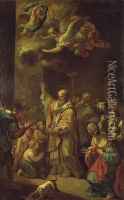Bon Boullogne Paintings
Bon Boullogne, born in 1649 in Paris, France, was a prominent French painter and draftsman of the Baroque period. His artistry was deeply influenced by the classical style and the works of Italian masters, reflecting the grandeur and solemnity that characterized the French Baroque movement. Boullogne's early life was steeped in an artistic milieu, with his father, Louis Boullogne the Elder, being a painter as well. This familial environment nurtured his talents and laid the groundwork for his future achievements in the arts. Boullogne's career was marked by significant accomplishments and contributions to French art. He was esteemed for his religious and mythological scenes, which were characterized by their dynamic compositions, delicate color palettes, and the emotional depth of the figures depicted. Boullogne's mastery in capturing the essence of the divine and the mythic made him a favored artist among the French aristocracy and clergy, leading to numerous commissions for churches and palaces, including the prestigious Palace of Versailles. In 1673, Boullogne further solidified his standing in the French art world by becoming a member of the Royal Academy of Painting and Sculpture. His involvement with the Academy, and later as a professor and rector, was instrumental in shaping the direction of French art, advocating for a balance between the academic rigor of the French tradition and the emotive expressiveness of the Baroque. Boullogne's legacy is not just in his own works but also in his influence on the next generation of artists, including his children, who continued the family tradition of painting. Bon Boullogne passed away in 1717, leaving behind a body of work that continues to be celebrated for its elegance, emotional depth, and technical prowess.


